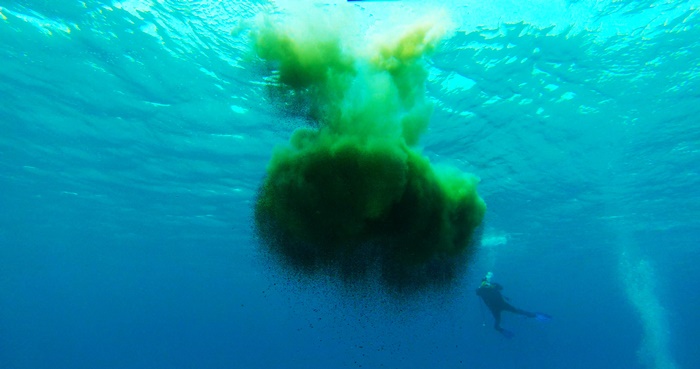
Dredge plume from capping of just 15 kg of sand. Sediment, such as harbour sludge, is released through the bottom of a split barge. Now anyone can quickly screen and assess predicted sediment spill using PlumeCast, right in their web browser. © DHI
Marine dredging is a huge industry with an expected annual turnover of USD 12.6 billion in the next five years. Examples of marine dredging activities at sea include nourishment of beaches to combat coastal erosion, land reclamation, raw material extraction, construction of port access channels and port basins, trenching of tunnels, pipelines and cables, as well as sand capping and encasing of contaminated seabed. Common to these activities is that seabed material is moved around annually in quantities measured in millions of cubic meters.
When the seabed is disturbed, fine sediments swirl around and create dredge plumes. The dredge plume is dispersed and carried away from the dredge site by ocean currents. As a result, the plume can reach areas far away from the source. Depending on size, duration and density, the dredge plume can pose a risk to nearby areas with sensitive marine nature, especially if organic and inorganic pollutants are bound to the sediments. The challenge with dredge plumes is that they are not always visible from the sea surface, making them difficult to assess. In some cases, marine dredging will lead to spreading of pollutants and trigger permanent and devastating changes in the marine environment.
PlumeCast – quickly predict dredging-related sediment spill plume dispersion through a web browser
Today, complex mathematical models are used to address this type of environmental impact and typically, these assessments are performed by experts. As part of ongoing research and development, DHI has developed PlumeCast, a cloud-based modelling tool to simulate sediment spreading from marine dredging. PlumeCast enables even non-modellers to make quantitative environmental assessments to a much greater extent than it is possible today.
DHI will continue to improve PlumeCast in 2021 to support both the utilisation and protection of marine resources. The focus is on integrating real-time field data into model simulations and leveraging new IoT capabilities to create data-driven models as a first step toward establishing a truly digital twin of sediment spreading.
Learn more about PlumeCast and see how it can support your marine projects: https://www.dhigroup.com/marine-water/plumecast-application
Contact:
Anders Chr. Erichsen
aer@dhigroup.com
Jacob H Jensen
jhj@dhigroup.com